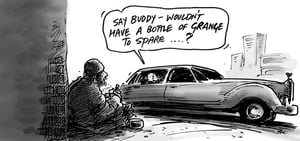When you look at SEIFA scores (Socio-Economic Indexes for Areas), Western Australia comes up pretty well. It has the highest scores, indicating more affluence, and higher incomes than any other state, and is only beaten by the ACT among the territories. The wealth generated by mining leads to a high income place, and a high cost of living as well in the West. But there are significant pockets of disadvantage among the affluence. id’s new National Demographic Indicators let us look at this geographic distribution.

The SEIFA index of disadvantage draws together disparate Census characteristics to form an aggregate measure of disadvantage. It includes things like unemployment, education levels, occupation types, and of course low incomes.
The higher the number, the less disadvantage (and generally, proportionally more advantage, though it is better at measuring the low end or lack of it). The Australian average is 1,002. Western Australia has an average of 1,021.
This map shows the distribution of socio-economic advantage and disadvantage across WA. If you’re interested in other states, you can do straight to the National Demographic Indicators website.
Peppermint Grove, a tiny one-suburb LGA on the western side of the Swan in Perth, is the most well-off LGA in the whole nation, with a SEIFA score of 1,126. This is where some of Australia’s richest people live. Other areas near the top of the list are Cambridge, Cottesloe, Nedlands and Claremont. All of these are proposed to be combined as a single council under the WA government’s metropolitan reform proposals, currently under review. It’s not really fair to compare Peppermint Grove to other LGAs in this way – most suburbs are larger than this whole LGA, and generally small areas are likely to have more extreme characteristics, either way.
There are relatively few LGAs in Perth which have low SEIFA scores – Metropolitan Perth is pretty well off, overall. However Armadale (996), Belmont (987) and Kwinana (968) do fall a little below the Australian average, indicating higher disadvantage. This is where Perth’s lower incomes are concentrated. And of course there are suburbs in these places and elsewhere which are considerably more disadvantaged. This is generally associated with public housing.
But it’s in regional WA where there seems to be quite extreme inequality – Perth is pretty well off overall, but how well off you are in regional WA seems to depend on whether you’ve got a mine in your area.
The most disadvantaged places in the state are remote indigenous communities, with populations over 50% Aboriginal. The lowest SEIFA score is in Halls Creek at 598, putting it in the bottom 0.1% of Australia’s population. Other low SEIFA scores include Ngaanyatjarraku (607), Menzies (612) and Upper Gascoyne (717).
Interestingly, while the highest SEIFA scores are in Perth, the highest incomes are in Regional WA. These areas score fairly well but not extremely high on SEIFA, but their median incomes are the highest in Australia.
These include The Shire of Roebourne ($2,839/week) – soon to be known as the City of Karratha. Port Headland ($2,809), Ashburton ($2,705) and East Pilbara ($2,695).
There is a large disconnect in these areas between incomes and the other indicators of advantage. For instance, in most areas (including Peppermint Grove), high incomes and high education levels (measured by % of university qualifications) go together. In Mining areas, the highest incomes are generally earned by people with trade or no qualifications, so you have the situation where Roebourne has the highest median income of any LGA in the whole nation (in fact all those 4 listed are above any other LGA in Australia) but only 11.4% of the population has a university qualification, well below the national average of 18.8%. Trade qualifications are a bit higher than the national average, at 25.6%, but you will find higher rates in many outer suburbs of our state capitals.
Roebourne has a relatively high SEIFA score at 1060, though not extreme. However there are pockets of very high disadvantage within Roebourne Shire. In fact Roebourne Town itself has a SEIFA score of 877, which is quite low, and has significant disadvantage. This is where atlas.id is very useful, as it can map SEIFA across your area and show pockets of major difference from the overall score. You can see Roebourne Shire’s atlas.id site here.
The situation is more extreme in East Pilbara. When measured by median, it has the 4th highest incomes in Australia but a SEIFA score of 962, below the Australian average. Education levels are very low (9.1% university qualifications) but this is only part of the story. Because the index measures the prevalence of low incomes, unskilled occupations, high population speaking a language other than English, social housing renters etc. it is picking up on some quite disadvantaged places, which the median income misses because it’s just a midpoint. Although .id don’t have a profile for East Pilbara, it’s clear that there is quite a polarization of characteristics, between the miners (and many of those are fly-in/fly-out as well, so not in the residential population) and the rest of the population, probably including the large (17%) indigenous population.
The highest SEIFA score in Regional WA is the farming area of the Shire of Kent (1,067) – despite its modest income of only $990/week, everyone is employed (truly – zero unemployment) and most people fully own their homes. There aren’t many very low incomes, just not many high ones either. So the SEIFA score reflects this. The Shire of Kent do have a community profile, via The Lakes VROC site.
There are plenty more stories for you to find in .id’s National Demographic Indicators site, which is available for everyone to access.
Visit our demographic resource centre to understand more about your area’s population and how it is changing. If you enjoyed this article, subscribe to our blog or newsletter and keep up-to-date with the latest demographic and population trends.












